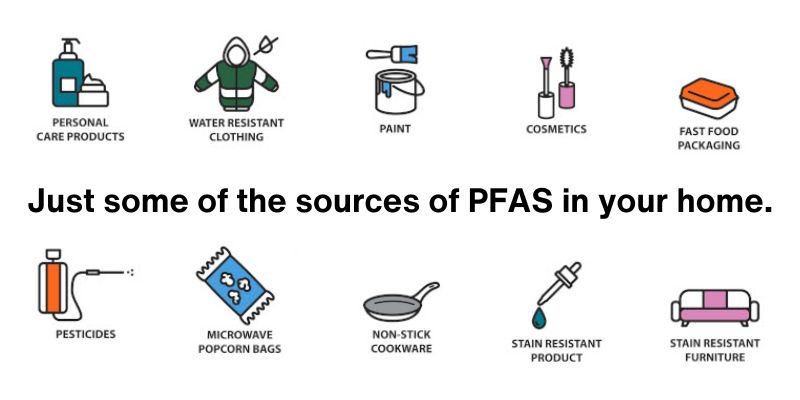There have been no detections at or above EPA minimum reporting levels.
So, what are PFAS?
So, what are PFAS?
Per- and Polyfluoroalkyl Substances (PFAS) are a group of manufactured chemicals that have been used in industry and consumer products since the 1940s because of their useful properties. There are thousands of different PFAS compounds, some of which have been more widely used and studied than others.
Perfluorooctanoic Acid (PFOA) and Perfluorooctane Sulfonate (PFOS) are two of the most widely used and studied chemicals in the PFAS group. Both have been phased out of use in the United States and replaced with other compounds in recent years.
One common characteristic of PFAS chemicals that is of concern is that many are resistant to breaking down in the environment and, over time, can build up in plants, animals (including the human body), and the environment.

While the science behind this emerging global issue of PFAS is still being studied, the City is taking early steps to share our testing data with the Albany community. We also continue to work with Federal and State regulators and other stakeholders, to understand, identify, and mitigate the impacts of PFAS on our community and vital water infrastructure systems.
We are sharing this webpage with you to help develop action plans as more information and science-based best practices become available and to bring greater awareness to the potential risks of PFAS in the Albany community.
Test results
Test results
In January 2023, the City of Albany began testing for 29 known PFAS compounds in our drinking water as part of the Unregulated Contaminate Monitoring Rule - Round 5 (UCMR5). The UCMR5 provides the EPA, Oregon Health Authority, and the City of Albany with scientifically valid data on the occurrence of these contaminants in drinking water. New testing methods and procedures will likely give us better data and help us understand this emerging issue. Drinking water from both water treatment plants were tested.
UMCR5 Test Results
| December 2023 | A-M WTP | Vine Street |
| September 2023 | A-M WTP | Vine Street |
| June 2023 | A-M WTP | Vine Street |
| March 2023 | A-M WTP | Vine Street |
Looking for more information on Albany's drinking water quality?
PPM, PPB, and PPT (No, it's not a PowerPoint file)
Your water is tested extensively to ensure it is safe. Water quality is usually reported in parts per million, billion or trillion. What does this mean in terms we can understand?
Parts per million (ppm)

You clean a 10-gallon fish tank and 1 drop splashes out.
Parts per billion (ppb)

You inherit $10 million. In counting it out, you discover 1 cent is missing.
Parts per trillion (ppt)

The sun is 93 million miles away. You move 6 inches toward it. That’s 1 ppt.
What can you do?
What can you do?
Reducing your use of products that contain these chemicals is the first step to controlling their impact on our environment.
- Check product labels for ingredients that include the words "fluoro" or "perfluoro"
- Look for PFAS-free alternative to dental floss, cosmetics, and other personal care products
- Be aware of packaging for food that contains grease-repellent coatings
- Avoid stain-resistance treatments
- Avoid or reduce the use of non-stick cookware
- Dispose of electronics, batteries, and pharmaceuticals properly
Are you looking for more resources to help reduce the impact of PFAS and the amount of trash in our landfills? Check out our Living Green page.
Possible health effects
Possible health effects of PFAS
Current research by the CDC has shown that people working in occupations such as firefighting or chemical manufacturing and processing can be exposed to PFAS. People can also be exposed by eating food grown or raised in PFAS-contaminated soil or water, including agricultural products, wild game, and fish.
According to the CDC and Oregon Health Authority, possible health effects from PFAS exposure include:
- Changes in blood lipid levels
- Changes in liver enzymes
- Small decreases in infant and fetal growth
- Lower antibody levels to vaccines in children
- Increased risk of high blood pressure in pregnant women
- Increased risk of kidney or testicular cancer in adults
Continued monitoring
The EPA issued a final rule on April 10, 2024 which set limits and also requires future monitoring.
Albany will continue to follow all Oregon Health Authority and EPA guidelines while sampling our water accordingly. Keeping our drinking water safe for all of Albany and Millersburg is our highest priority.




